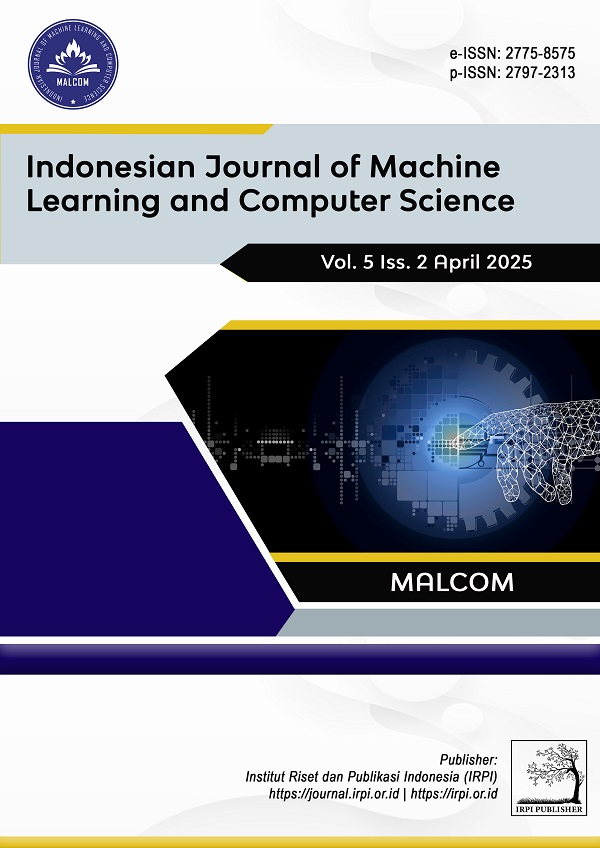Implementasi Algoritma Machine Learning untuk Klasifikasi Suara Lingkungan
Implementation of Machine Learning Algorithm for Environmental Sound Classification
DOI:
https://doi.org/10.57152/malcom.v5i2.1712Keywords:
Algoritma, Klasifikasi, Machine Learning, Suara, Suara LingkunganAbstract
Suara lingkungan memiliki peran signifikan dalam menentukan kualitas hidup manusia dan keseimbangan ekosistem. Dengan meningkatnya urbanisasi dan perubahan iklim, pemantauan suara lingkungan menjadi krusial. Penelitian ini mengimplementasikan algoritma Machine Learning untuk mengklasifikasikan suara lingkungan menggunakan dataset ESC-50. Fitur-fitur seperti Mel-Frequency Cepstral Coefficients (MFCCs) dan Chroma digunakan untuk ekstraksi ciri. Setelah pra-pemrosesan data, dilakukan pemodelan dengan berbagai algoritma, termasuk KNeighbors Classifier, Random Forest Classifier, dan Extra Tree Classifier, yang kemudian dipilih untuk tuning hyperparameter. Dengan parameter optimal, dilakukan training pada model terpilih dan diuji pada dataset uji. Hasil menunjukkan KNeighbors Classifier memiliki akurasi tertinggi sebesar 63%. Studi ini memberikan kontribusi pada pengembangan teknologi pemantauan suara lingkungan dan membuka prospek penerapan dalam manajemen kota yang lebih efisien. Studi lanjutan disarankan untuk eksplorasi fitur-fitur suara yang lebih spesifik, penggunaan teknik deep learning, dan penggunaan dataset yang lebih luas untuk solusi yang lebih canggih dalam pemahaman dan manajemen suara lingkungan secara global.
Downloads
References
M. C. Kondo, J. M. Fluehr, T. McKeon, and C. C. Branas, “Urban green space and its impact on human health,” Mar. 03, 2018, MDPI. doi: 10.3390/ijerph15030445.
W. Octovianus and R. Sugiarto, “KAJIAN SOUNDSCAPE SEBAGAI KRITIK TERHADAP PROPORSI DAN ELEMEN ARSITEKTURAL DI JALAN BRAGA, BANDUNG,” LANGKAU BETANG: JURNAL ARSITEKTUR, vol. 9, no. 2, p. 156, Oct. 2022, doi: 10.26418/lantang.v9i2.53651.
H. P. Kunc and R. Schmidt, “The effects of anthropogenic noise on animals: A meta-analysis,” Biol Lett, vol. 15, no. 11, Nov. 2019, doi: 10.1098/rsbl.2019.0649.
L. Yang, X. Liu, W. Zhu, L. Zhao, and G. C. Beroza, “Toward improved urban earthquake monitoring through deep-learning-based noise suppression,” 2022. [Online]. Available: https://www.science.org
L. S. P. Annabel, S. P. G, and T. V, “Environmental Sound Classification Using 1-D and 2-D Convolutional Neural Networks,” pp. 1242–1247, 2023, doi: 10.1109/iceca58529.2023.10395326.
H. A. Salman, A. Kalakech, and A. Steiti, “Random Forest Algorithm Overview,” Deleted Journal, vol. 2024, pp. 69–79, 2024, doi: 10.58496/bjml/2024/007.
“Varying Coefficient Linear Discriminant Analysis for Dynamic Data,” 2022, doi: 10.48550/arxiv.2203.06371.
J. Singh, “pyAudioProcessing: Audio Processing, Feature Extraction, and Machine Learning Modeling,” 2022. [Online]. Available: https://developers.google.com/learn/pathways/get-started-audio-
B. Ghani and S. Hallerberg, “A Randomized bag-of-birds Approach to Study Robustness of Automated Audio Based Bird Species Classification,” 2021, doi: 10.20944/preprints202108.0277.v1.
N. N. W. N. Hashim, M. A. E. A. Ezzi, and M. D. Wilkes, “Mobile microphone robust acoustic feature identification using coefficient of variance,” Int J Speech Technol, vol. 24, no. 4, pp. 1089–1100, Dec. 2021, doi: 10.1007/s10772-021-09877-1.
A. Anikin and N. Johansson, “Implicit associations between individual properties of color and sound,” Atten Percept Psychophys, vol. 81, no. 3, pp. 764–777, Apr. 2019, doi: 10.3758/s13414-018-01639-7.
M. J. Grotevent et al., “Integrated photodetectors for compact Fourier-transform waveguide spectrometers,” Nat Photonics, vol. 17, no. 1, pp. 59–64, Jan. 2023, doi: 10.1038/s41566-022-01088-7.
N. Konda, R. Verma, and R. Jayaganthan, “Machine learning based predictions of fatigue crack growth rate of additively manufactured ti6al4v,” Metals (Basel), vol. 12, no. 1, Jan. 2022, doi: 10.3390/met12010050.
J. He and Z. Zeng, “Efficient Feature Selection via Joint Neural Network and Pruning,” in Frontiers in Artificial Intelligence and Applications, IOS Press BV, 2022, pp. 138–145. doi: 10.3233/FAIA220019.
A. M. Elshewey, “hyOPTGB: An EEcient OPTUNA Hyperparameter Optimization Framework for Hepatitis C Virus (HCV) Disease Prediction in Egypt hyOPTGB: An Efficient OPTUNA Hyperparameter Optimization Framework for Hepatitis C Virus (HCV) Disease Prediction in Egypt,” 2023, doi: 10.21203/rs.3.rs-2768795/v1.
A. Vabalas, E. Gowen, E. Poliakoff, and A. J. Casson, “Machine learning algorithm validation with a limited sample size,” PLoS One, vol. 14, no. 11, Nov. 2019, doi: 10.1371/journal.pone.0224365.
G. Gayathri, P. Priyanka, B. Manjeera, K. Niharika, V. P. K. S, and V. K. K. Kolli, “An Extra Tree Classifier for prediction of End to End Customer Churn and Retention,” pp. 1–6, 2024, doi: 10.1109/apcit62007.2024.10673618.
T.-T. Vo, U. J. Dang, and T. H. Nguyen, “Weighted Missing Linear Discriminant Analysis: An Explainable Approach for Classification with Missing Data,” 2024, doi: 10.48550/arxiv.2407.00710.
M. Fleissner, M. Zarvandi, and D. Ghoshdastidar, “Decision Trees for Interpretable Clusters in Mixture Models and Deep Representations,” 2024, doi: 10.48550/arxiv.2411.01576.
O. O. Kyrsanov and S. Krivenko, “Feature engineering for the implementation of machine learning in clinical data processing,” Ìnfokomunìkacìjnì tehnologìï ta elektronna ìnženerìâ, vol. 4, no. 2, pp. 162–171, 2024, doi: 10.23939/ictee2024.02.162.
S. K. Safi and S. Gul, “An Enhanced Tree Ensemble for Classification in the Presence of Extreme Class Imbalance,” Mathematics, 2024, doi: 10.3390/math12203243.
B. Ghasemkhani, K. F. Balbal, and D. Birant, “A New Predictive Method for Classification Tasks in Machine Learning: Multi-Class Multi-Label Logistic Model Tree (MMLMT),” Mathematics, vol. 12, no. 18, p. 2825, 2024, doi: 10.3390/math12182825.
H. Kaur, T. Kaur, V. Bhardwaj, and M. Kumar, “An ensemble deep learning model for classification of students as weak and strong learners via multiparametric analysis,” Deleted Journal, vol. 6, no. 11, 2024, doi: 10.1007/s42452-024-06274-6.
H. Wang, “Development and validation of an Adaboost model for breast cancer classification,” Applied and Computational Engineering, vol. 67, no. 1, pp. 107–114, 2024, doi: 10.54254/2755-2721/67/20240643.
C. Annamalai, “The Gaussian Integral for the Normal Distribution in Machine Leaning,” 2024, doi: 10.33774/coe-2024-p4j6k.
F. Guo, D. M. Zucker, K. I. Vaden, S. G. Curhan, J. R. Dubno, and M. Wang, “New Quadratic Discriminant Analysis Algorithms for Correlated Audiometric Data,” Stat Med, 2024, doi: 10.1002/sim.10257.
A. Marakhimov, K. Khudaybergenov, Z. Muminov, and J. Kudaybergenov, “Logistic Regression with Multi-Connected Weights,” Journal of Computer Science, vol. 20, no. 9, pp. 1051–1058, 2024, doi: 10.3844/jcssp.2024.1051.1058.
S. Hakkal and A. A. Lahcen, “XGBoost To Enhance Learner Performance Prediction,” Computers & Education: Artificial Intelligence, vol. 7, p. 100254, 2024, doi: 10.1016/j.caeai.2024.100254.
F. C. Opone and C. Chesneau, “Study of the inverse continuous Bernoulli distribution,” Malaya journal of matematik, vol. 12, no. 03, pp. 253–261, 2024, doi: 10.26637/mjm1203/003.
M. H. Zahri, A. S. Sunge, and A. T. Zy, “Analysis of Product Sales in the Application of Data Mining with Naive Bayes Classification,” Journal of Computer Networks, Architecture and High Performance Computing, 2024, doi: 10.47709/cnahpc.v6i3.4255.
F. Artuso et al., “Identifying optimal feature sets for acoustic signal classification in environmental noise measurements,” NOISE-CON ... proceedings, 2024, doi: 10.3397/in_2024_3974.
Downloads
Published
How to Cite
Issue
Section
License
Copyright (c) 2025 MALCOM: Indonesian Journal of Machine Learning and Computer Science

This work is licensed under a Creative Commons Attribution-ShareAlike 4.0 International License.
Copyright © by Author; Published by Institut Riset dan Publikasi Indonesia (IRPI)
This Indonesian Journal of Machine Learning and Computer Science is licensed under a Creative Commons Attribution-ShareAlike 4.0 International License.




















